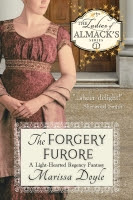 I have any number of friends who live for sales. Around here, the semiannual sale at Nordstom’s Rack is big news, and there are those who rejoice at a 50% off coupon for Chico’s. Me—I eagerly await one day, the biggest shopping day of the year for me, the first Saturday in May: the Methodist Rummage Sale five dollar a bag special! You know where I’ll be this afternoon.
I have any number of friends who live for sales. Around here, the semiannual sale at Nordstom’s Rack is big news, and there are those who rejoice at a 50% off coupon for Chico’s. Me—I eagerly await one day, the biggest shopping day of the year for me, the first Saturday in May: the Methodist Rummage Sale five dollar a bag special! You know where I’ll be this afternoon.Ladies in nineteenth century London also looked for ways to extend their fashion budget. For a good part of the century, all clothes were handmade, specifically for you. You might go to a shop and have your measurements taken for a new gown, or a seamstress might come to your house and measure you. If the cost of a seamstress was too dear, you might purchase fabric and sew your own gown (very likely by hand, although home sewing machines became more common toward the end of the century). But if even that was beyond your budget, you had several alternatives.
 You could remake an older dress, either one of yours or one belonging to a willing relative like your mother or older sister. Particularly as the fashions changed later in the century it was relatively easy to pull off bodices and reattach them to different skirts. Changing rickrack was equally easy and a quick way to change the look of an outfit. If the older dress had a lot of fabric and the newer style used less, you could pick apart the older dress and make a complexly new one.
You could remake an older dress, either one of yours or one belonging to a willing relative like your mother or older sister. Particularly as the fashions changed later in the century it was relatively easy to pull off bodices and reattach them to different skirts. Changing rickrack was equally easy and a quick way to change the look of an outfit. If the older dress had a lot of fabric and the newer style used less, you could pick apart the older dress and make a complexly new one. You could also buy someone else’s gown. Wealthy mistresses often handed gowns that had fallen out of favor for one reason or another to their maids, who took them to second-hand shops in less prosperous parts of the city, such as near the docks. During the latter part of the eighteenth century, in fact, second-hand clothing was a lucrative export from England to America!
Oh, how they would have loved the Methodist Rummage Sale!





No comments:
Post a Comment